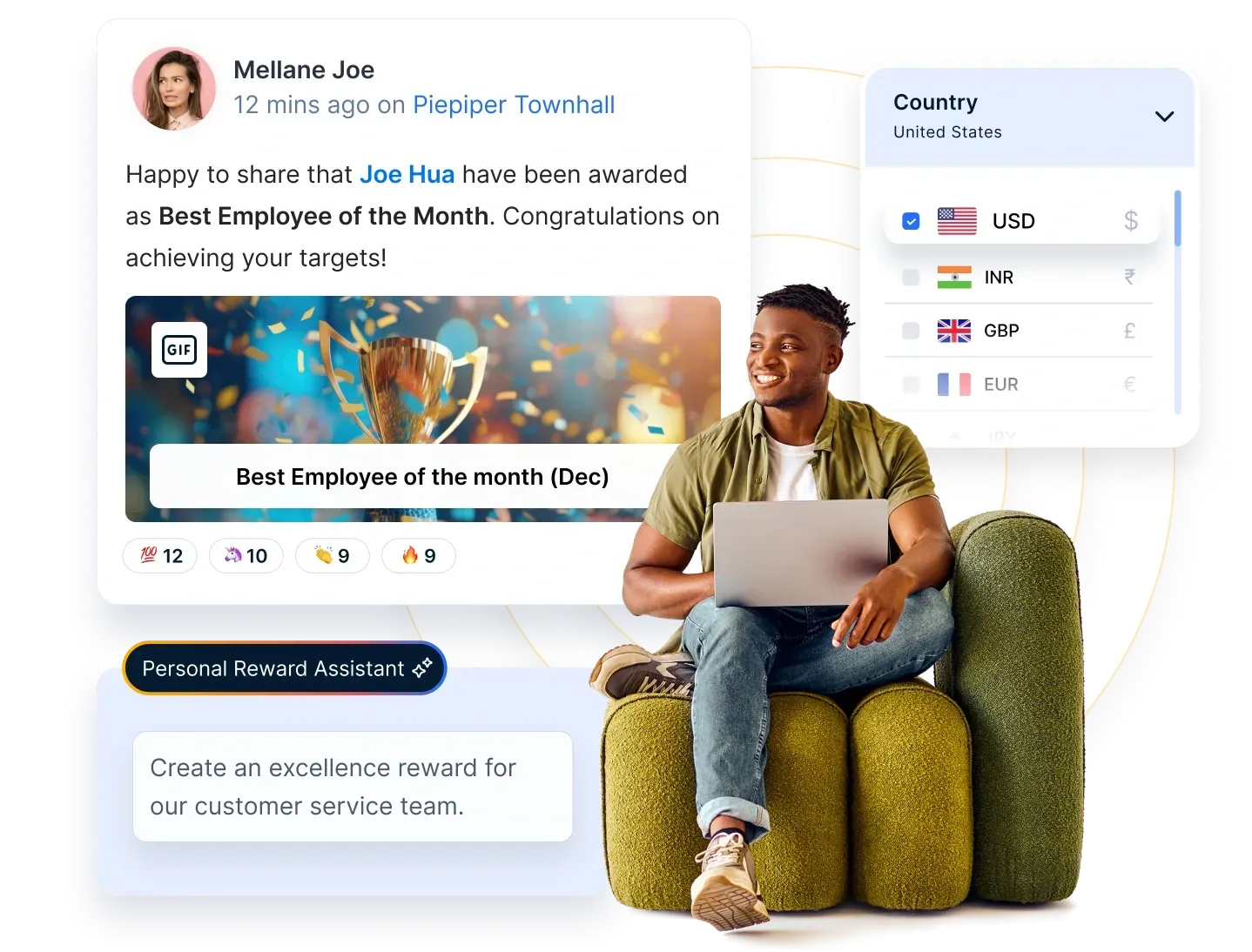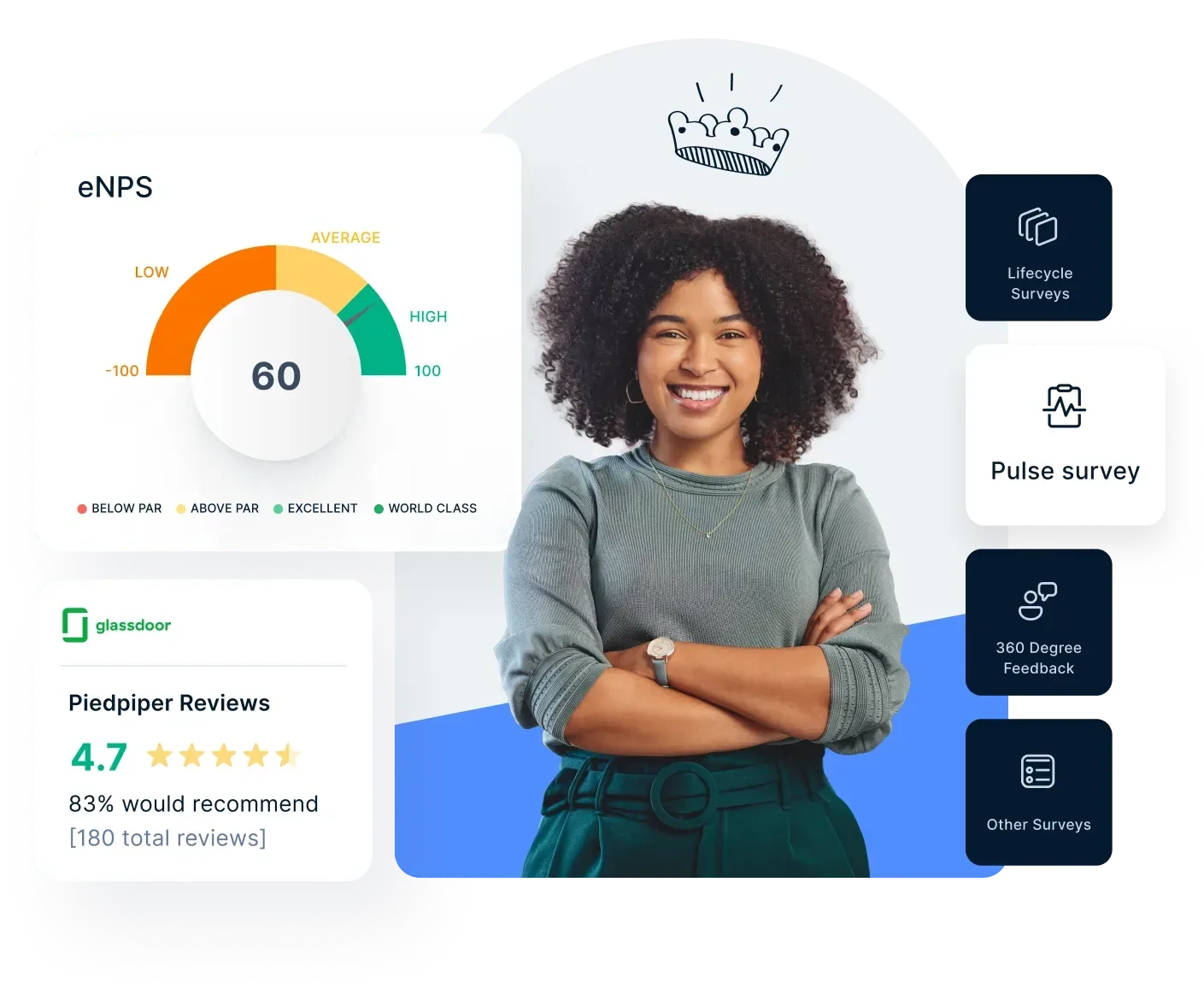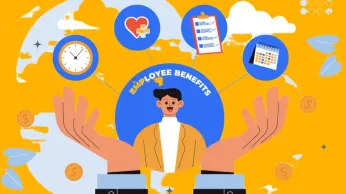How to Improve Employee Experience with Proven Strategies
Businesses that optimize employee experience see higher retention and productivity from onboarding to recognition programs. Explore the best tips for improving employee experience and build a workplace where employees want to stay.
On this page
A Glassdoor cultural survey found that 77% of job seekers consider employee experience a key factor when choosing a company. With turnover rates increasing, organizations must focus on employee experience management to boost morale, engagement, and retention.
A motivated workforce improves company culture and fosters loyalty. Gallup research shows that engaged workplaces experience 59% lower turnover, while employees who find their work purposeful are far more likely to stay and recommend their company.
However, improving employee experience goes beyond assigning tasks and tracking progress. It’s about creating a work environment where employees feel valued, heard, and fulfilled. This is where employee experience management plays a crucial role—ensuring a positive workplace that retains top talent for the long run.
Let’s explore how you can make this happen in your organization.
Why focus on employee experience?
Companies must find creative ways to attract, motivate, and retain talent to succeed in today's highly competitive global market. In addition, since an average employee spends over one-third of their adult life at work, employers must give employees the best experience possible.
It starts with a candidate’s first encounter with your company and continues during their journey along the employee lifecycle—from the recruitment phase until the separation phase.
An MIT research has shown that enhancing employee experience predicts twice the innovation and 25 percent greater company profitability. Therefore, companies looking to benefit from improved bottom-line results must prioritize enhancing the employee experience.
Many business leaders recognize the importance of enhancing the employee experience but do not know how to do so.
A study by Deloitte has shown that “nearly 80 percent of executives rated employee experience as very important, but only 22 percent reported that their companies were excellent at building a differentiated employee experience.”
So, what does it take to create a differentiated employee experience? This is where you, as an HR leader, can help.
Companies can create a positive employee experience by implementing an employee total rewards strategy.
According to SHRM, an employee total rewards strategy rewards employees who achieve business goals by offering them compensation, benefits, and personal growth opportunities in a motivating work environment.
In other words, a total rewards package provides a holistic employee experience because it covers different components that drive employee satisfaction, engagement, wellness, and alignment. Consequently, companies enjoy better financial success since total rewards motivate high-performing employees to remain productive.
Tying total rewards to employee experience management
An attractive total rewards package offers companies a competitive advantage and is crucial in influencing people’s decisions to join and remain with a company. As part of employee experience management, organizations must ensure their rewards strategy aligns with employee expectations to drive satisfaction and long-term retention.
To improve employee experience, companies can offer a well-designed total rewards package that includes monetary and non-monetary rewards. A comprehensive approach that caters to employees’ diverse needs fosters engagement, motivation, and loyalty. At different touchpoints of the employee experience, total rewards play a key role in attracting, motivating, and retaining employees.
For example, prospective employees evaluate various aspects of a company during the recruitment stage. Platforms like Glassdoor, where employees share insights on culture, salaries, incentives, and benefits, significantly impact candidates' decisions. From the start, ensuring transparency and offering compelling rewards enhance the employee experience management process.
Similarly, onboarding is another critical touchpoint in the employee experience. When candidates accept an offer and join the company, they enter a phase that can determine their long-term commitment.
Based on my experience as an HR professional, “onboarding is a make-or-break period for a new hire.” HR teams must guide new employees through their compensation, benefits, and total rewards structure to create a positive and seamless transition. A strong onboarding process not only improves employee experience but also strengthens overall retention efforts.
How to improve employee experience with monetary rewards
Monetary rewards typically include any form of financial compensation a company provides in exchange for an employee’s contributions, expertise, and time. These rewards allow employees to calculate their financial value and compare them with offers from other companies.
However, beyond just compensation, businesses must also focus on optimizing employee experience by ensuring that financial incentives align with job satisfaction and career growth. Incorporating tips for improving employee experience, such as performance-based bonuses and personalized incentives, can help companies retain top talent while keeping employees motivated and engaged.
Some of the popular monetary reward ideas to enhance employee experience include:
1. Base pay
This refers to an employee’s basic compensation, usually offered as a wage or salary. Base pay helps employees compare how well they are being paid with what other employers could offer them for doing similar work.
For a better employee experience, workers must understand how their pay is determined. It helps them know if what they are paid is equivalent to their expertise.
2. Variable pay
Employees receive performance-based compensation from the individual, team, or organizational contributions over a certain period. Variable pay includes merit pay, bonuses, incentives, sales commissions, gain sharing, and profit-sharing.
There is little room for comparison with variable pay since performance can vary at the individual, team, or organizational levels. Still, variable pay helps to motivate employees because it is usually commensurate with their contributions.
3. Benefits
Many employees receive benefits such as paid time off, health insurance, life, and disability insurance, retirement plans, perks, employee assistance programs, or wellness programs as a form of indirect monetary rewards from their employers. However, it is important to note that employee benefits differ globally.
For example, certain benefits are required in the United States under state and federal regulations, while others are discretionary.
You will also find that employee benefits can be categorized as government-provided, government-mandated, and voluntarily provided by companies in other countries. If your company operates globally, expect to follow each country’s requirements for providing employee benefits.

Build a Workplace Where Employees Thrive
Enhance engagement with meaningful recognition, continuous feedback, and personalized rewards. Empuls helps you build a thriving workplace culture where employees feel valued and motivated.
How to improve employee experience with non-monetary rewards
Non-monetary rewards are often seen as intangible because employees cannot easily calculate or compare their financial value. The perceived value of each reward varies based on individual preferences. While one employee may appreciate flexible work schedules to balance personal commitments, another may prioritize career development opportunities.
These rewards are crucial in optimizing employee experience and making job opportunities more appealing. A well-designed total rewards package enhances employee satisfaction and fosters an emotional connection with the company, ultimately enhancing employee experience.
Recognizing the significance of non-monetary rewards, businesses are investing heavily in these strategies. The Incentive Marketplace Estimate Research Study found that 84% of U.S. businesses use non-monetary rewards to acknowledge their employees, sales teams, and customers, spending $90 billion annually.
For companies looking to retain top talent, implementing tips for improving employee experience, such as personalized rewards and recognition programs, is becoming a key focus.
Some of the popular non-monetary reward ideas to improve employee experience include:
1. Opportunities for advancement
As humans, we crave opportunities for growth in our lives. Likewise, employees feel motivated when they have those opportunities in the workplace. When employees can’t find such opportunities, they leave for another company.
A survey by The Harris Poll showed that most employees quit their jobs because they craved career development opportunities. Having understood how significant advancement opportunities are to employees, companies can motivate and engage employees by investing in their learning and development, offering them stretch assignments, and defining clear career maps.
2. Flexible work schedules
Employees often struggle to balance their lives because they spend most of their time at work. However, in recent years, some companies—especially those in the technology sector—started embracing a flexible work culture.
Allowing employees to work remotely or have flexible schedules gives them more time to focus on their personal lives. When the COVID-19 pandemic started, companies had to adapt to remote working to curb the disease’s transmission.
According to a Gartner survey, 88 percent of organizations have encouraged or required employees to work from home since the pandemic started.
Even though many workers are now working at home, now more than ever, it is still important for employees to have some flexibility since it’s easy to expect them to work longer hours.
During this time of social distancing and remote working, personal responsibilities, zoom fatigue, and employers’ increasing demands can affect employees’ mental health. However, you can create a positive experience for employees through flexible work schedules, which allow them to remain motivated to do their jobs.
3. Recognition
Employee recognition goes beyond a simple “thank you”—it’s a crucial element in optimizing employee experience and fostering long-term engagement. When employees feel valued for their contributions, they are more motivated, productive, and committed to the company.
Recognition can take many forms, from public appreciation in team meetings to personalized rewards and peer-to-peer shoutouts. Companies implementing tips for improving employee experience often use structured recognition programs that acknowledge achievements, milestones, and outstanding performance.
A well-designed recognition system enhances job satisfaction, strengthens workplace culture, and encourages loyalty. Businesses prioritizing recognition as part of their employee experience strategy see higher morale, reduced turnover, and a more engaged workforce.
Whether through non-monetary rewards, digital recognition platforms, or leadership acknowledgment, recognizing employees plays a key role in building a thriving work environment.
For example, Empuls' global catalogue gives users from 70+ countries access to 20,000+ reward options such as gift cards, experiences, perks, savings, vouchers, merchandise, subscriptions, and many more. So, when employees know that there's an excellent employee recognition culture, they can feel motivated to work harder to enjoy those rewards.
Some companies have successfully used their total rewards strategies to improve the employee experience.
Luminous India's new rewards and recognition program helped break down silos, encourage collaboration, and increase employee appreciation. For employees to enjoy a positive experience through your total rewards package, here are a couple of points to note:
- Ensure that it's cost-effective, sustainable, and effectively offering value to employees.
- Employees need to know what is available. You can help employees understand how to maximize their benefits and rewards options.
10 Tips to enhance the employee experience management process
Here are 10 practical strategies that can help you improve employee experience management in your organization:
1. Promote a supportive and collaborative workspace
Employees can work at their preferred time and in their preferred setting thanks to a flexible work environment. It has been proven that allowing flexibility in the workplace increases productivity and improves health and job fulfillment while lowering stress, organizational expenses, and absenteeism.
Additionally, it's critical for employers to foster inclusivity and diversity by observing how employees interact and collaborate, then by recognizing inclusive actions. Educating all managers about unintentional bias and taking action to reduce hostile interactions at work are sensible measures.
Finally, fostering a culture of appreciation is a fantastic approach to boosting employee morale and inspiring others to strive for similar accomplishments. Excellent ways to highlight employees' achievements include:
- Awarding for their achievements
- Encouraging them to write blog posts for the company website
- Publicizing their accomplishments on company social media networks
2. Respond to employee feedback
The most effective way to learn what your employees need from you is to ask their honest feedback and pay attention to their responses. Nowadays, several technological solutions are available to help collect continuous employee feedback, such as the employee surveys tool from Empuls.
Using this tool frequently, you may learn what employees appreciate about your company and what they believe still needs to be incorporated.
However, it's imperative that a culture of respect already exists in the company in order to receive genuine and constructive criticism. Employees are less likely to open up to you honestly if they feel ignored or disregarded in everyday conversations.
3. Enhance your management skills
Managers themselves are employees of the company. Therefore, they must be open-minded to recognize distinct employee personalities and adopt a different approach to deal with them. This is especially useful for businesses with staff members from diverse work divisions, age groups, seniority, and even ethnicities.
To become a better manager, develop soft skills like empathy, one-on-one coaching, and conflict resolution, host or attend mentorship programs, and organize support groups.
4. Define your parameters
While you might be tempted to evaluate all facets of employee experiences at once, doing so in a comprehensive strategy would take too much time and can turn out to be confusing.
Instead, set aside some time to define the goal of your research. Choose the aspect of the work cycle you wish to track, such as technology, workplace culture, or touchpoints for onboarding. Next, specify your expectations and decide which potential result is pertinent.
5. Deliver excellent communication
Better communication is the key to strengthening your connections with your employees, just like in any other partnership.
Although most HR managers and executives acknowledge the value of communication, they ultimately spend more time talking to the media, stakeholders, and their target audience than they do communicating with their own staff.
To improve communication and collaboration, introduce a robust platform, like Empuls' employee communication tool.
You can use employee communication tools to share good and bad news, celebrate your employees' significant accomplishments in their personal and professional lives, and clearly define your company's mission and vision.
6. Establish policies and define guidelines
Remote employees typically sit in front of their screens for a prolonged time. This could have a negative effect on their health and eventually lead to burnout.
Therefore, establishing guidelines helps to ensure employees don't feel overburdened with work and keeps them from slacking off. You can adopt the following policies to regulate the remote work model in your company:
- Limit phone calls and emails to specific times of the day Most business phone systems have the option of making these kinds of limitations.
- Plan virtual meetings with both local and remote employees
- Define compensation and benefits for remote employees
7. Incorporate surveys and questionnaires
When anonymity is preferred, surveys and questionnaires provide a quick and discrete way to evaluate employee experience. Establishing KPIs and then creating pertinent questions around them can help you get the most out of them.
Employee satisfaction can be determined by asking them to rate how meaningful they find their work on a scale of 1 to 5.
Employee productivity can be evaluated on a scale of 1 to 5 by asking about the resources and tools offered to staff to help them complete their daily tasks.
Asking about whether or not employees are likely to stay with the company if offered an identical position by another company might help you evaluate employee engagement.
8. Adopt automation
Improving the employee experience is a multifaceted task requiring various strategies, from effective communication to meaningful work. However, implementing these improvements can be challenging without the proper tools.
Automating some steps of the orientation and onboarding procedures is one method to make things easier. Video calls, for instance, can be used to introduce new personnel to existing staff members.
Additionally, allocating work assignments and partners can be streamlined by adopting a learning management system (LMS) or an employee experience management platform like Empuls.
Proving that good employee experience leads to great customer experience
Gartner's research states that "Customer Experience (CX) is the new marketing battlefront." As a result, 90 percent of the companies compete on customer experience.
If it is hard to sell, sustaining the sale that results in a satisfied customer is ten times harder. With an enhanced focus on customer satisfaction, the need to make employees happy and have a wholesome work experience is extremely important.
A study by Dr Paul Warner shows that employee satisfaction leads to customer satisfaction by an R factor (correlation coefficient) of .431. The same survey qualitatively mapped the customer satisfaction responses against the satisfaction responses of the employees who served these customers. The results showed how both these values were reflective of each other.
Some examples of how a bad employee experience can impact customer experience:
- If not trained well, they can provide incorrect or misleading information to the customer, negatively impacting customer happiness.
- Without discipline and focus on customer happiness, customer issues can be handled shabbily.
- Having a bad working atmosphere will lead to a high churn rate. When a customer finds a new support representative, it impacts the service provider's credibility as an employer.
- We have seen employees writing an escalation to the customer complaining about their employee.
- Client-sensitive information can be mishandled, and more.
Enhancing employee experience with Empuls

A great employee experience goes beyond daily tasks and paychecks—it is about fostering a workplace where employees feel valued, heard, and connected. Employees who have a positive experience are more engaged, productive, and committed to the organization.
This is where Empuls helps businesses create a seamless and enriching work environment. By integrating recognition, rewards, communication, and feedback into one platform, Empuls enables organizations to nurture a culture that enhances every stage of the employee journey.
How Empuls transforms the employee experience
- Recognition that builds motivation: Celebrate achievements, big or small, with peer-to-peer recognition and meaningful rewards that reinforce a culture of appreciation.
- Continuous employee feedback: Gather real-time insights with surveys and sentiment analysis to understand employee expectations and take proactive action.
- Stronger workplace connections: Foster engagement with a social intranet, helping employees collaborate, communicate, and stay connected—especially in remote and hybrid teams.
- Personalized benefits and incentives: Offer tax-free fringe benefits, wellness perks, and exclusive discounts to improve job satisfaction and overall well-being.
- Automated engagement initiatives: Create milestone celebrations, engagement campaigns, and reward programs that keep employees invested in their workplace experience.
A well-designed employee experience strategy helps businesses retain top talent, boost morale, and drive long-term success. Empuls makes this possible by providing organizations with the right tools to create an inclusive, rewarding, and engaging work environment.
How Gulf Taleed transformed employee experience with Empuls
Gulf Taleed, a leading retail distributor, faced low employee engagement and a lack of structured recognition. Their workforce needed a solution that fostered motivation, appreciation, and a strong sense of belonging.
With Empuls, Gulf Taleed implemented a digital rewards and recognition program, empowering employees to celebrate achievements, earn meaningful rewards, and feel valued for their contributions. The platform also helped managers offer instant feedback, ensuring consistent organizational engagement.
Key results
- Increased engagement: Employees actively participated in recognition and rewards programs, boosting morale.
- Stronger workplace culture: Peer-to-peer recognition fostered a collaborative and appreciative environment.
- Seamless reward distribution: Digital incentives made rewarding employees more manageable and more impactful.
Using Empuls, Gulf Taleed built a culture where employees feel recognized, motivated, and connected, leading to a positive employee experience that drives long-term retention and productivity.
Conclusion
Improving employee experience isn’t just about offering competitive salaries or perks—it’s about creating a workplace where employees feel valued, engaged, and motivated. Organizations can build a culture that fosters long-term retention and productivity by focusing on strategies that optimize employee experience, such as meaningful recognition, career development, and personalized rewards.
Implementing tips for improving employee experience—from enhancing onboarding to providing flexible work options—helps create a positive work environment where employees thrive. Businesses prioritizing these initiatives will retain top talent and build a more resilient and high-performing workforce.















